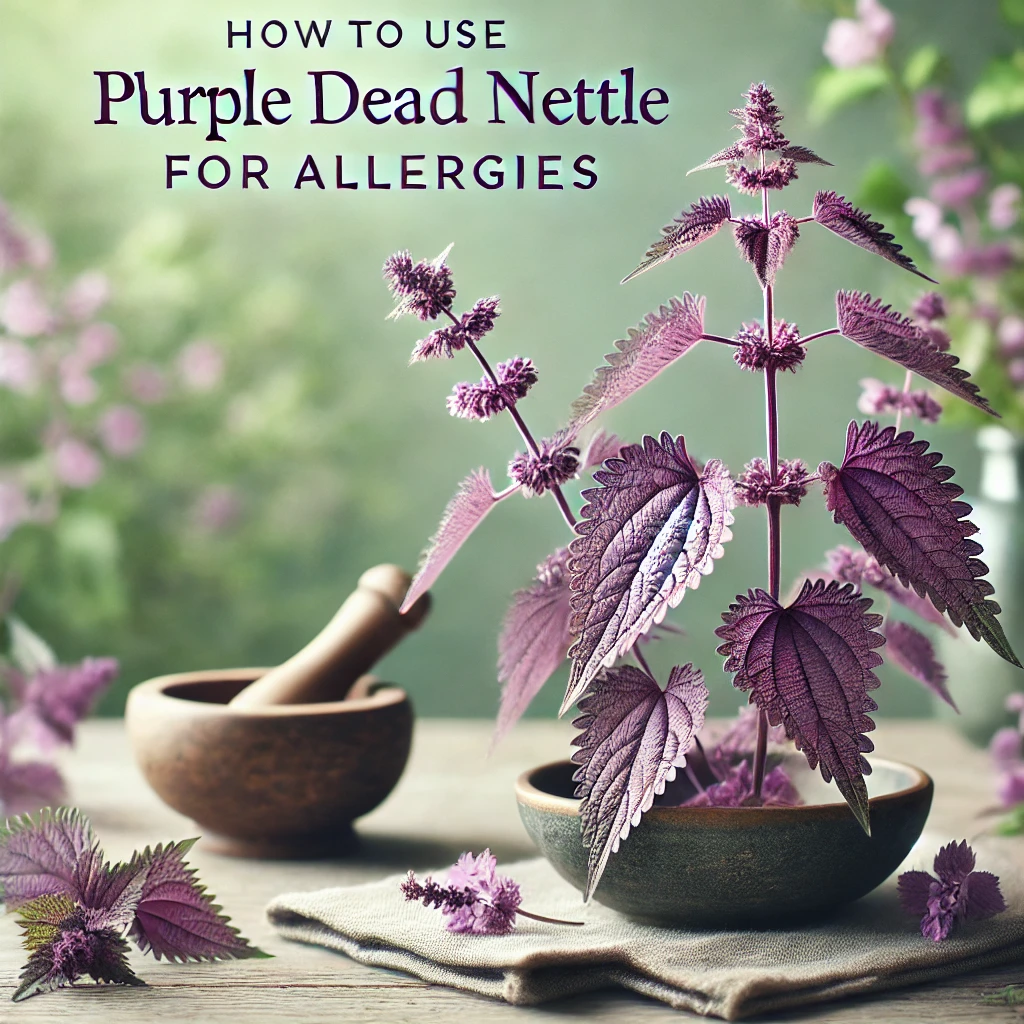Purple dead nettle (Lamium purpureum) is a common wild plant that is often overlooked despite its many health benefits. It is particularly popular in herbal remedies, offering support for seasonal allergies and other ailments. This vibrant plant is rich in antioxidants, anti-inflammatory properties, and can be used in various forms, from teas to tinctures. If you suffer from seasonal allergies or hay fever, learning how to use purple dead nettle may provide natural relief.
In this guide, we will discuss how purple dead nettle can be used for allergies, its health benefits, how to make tinctures, teas, and much more.
The Benefits of Purple Dead Nettle for Allergies
Purple dead nettle is known for its medicinal properties, which make it a great natural remedy for treating mild seasonal allergies. Some of the key benefits include:
- Anti-inflammatory properties: The plant’s anti-inflammatory benefits help reduce symptoms like itchy eyes, a runny nose, and sneezing caused by allergens.
- Antioxidants: Purple dead nettle is rich in vitamins and antioxidants that help boost the immune system, allowing it to better combat pollen and allergens.
- Antihistamine effects: This plant contains natural compounds that can reduce histamine production in the body, thus alleviating allergic reactions.
These benefits make purple dead nettle an effective natural remedy for allergy sufferers, and the plant can be used in various forms to provide relief.
How to Use Purple Dead Nettle for Allergy Relief
Purple dead nettle can be incorporated into your allergy relief routine in different forms, depending on your preference. Below are some popular ways to use it effectively.
1. Purple Dead Nettle Tea for Allergies
One of the easiest ways to consume purple dead nettle for allergy relief is by making tea. The tea provides all the essential nutrients and benefits that help reduce inflammation and soothe allergy symptoms.
How to Make Purple Dead Nettle Tea:
- Harvest fresh purple dead nettle leaves (make sure to pick leaves from areas free of pesticides or contaminants).
- Wash the leaves thoroughly.
- Dry the leaves using a dehydrator or by air-drying them in a cool, shaded area.
- Once dried, crush the leaves and store them in an airtight container.
- To make tea, boil water and steep 1 to 2 teaspoons of dried leaves for 10 minutes.
- Strain and enjoy your tea up to two times a day during allergy season for relief.
2. Purple Dead Nettle Tincture for Allergies
Another way to use purple dead nettle for allergies is by making a tincture. Tinctures are concentrated liquid extracts that are easy to use and store, making them an excellent option for long-term use.
How to Make a Purple Dead Nettle Tincture:
- Gather a fresh batch of purple dead nettle leaves and stems.
- Fill a clean glass jar halfway with the plant material.
- Pour vodka (or any high-proof alcohol) into the jar until the herbs are fully submerged.
- Seal the jar tightly and store it in a cool, dark place for 4-6 weeks, shaking it every few days.
- After the steeping period, strain out the plant material using a cheesecloth or strainer.
- Store the liquid tincture in a dark dropper bottle.
To use, take 10-20 drops of the tincture up to three times a day during allergy season. Always consult your healthcare provider before starting any herbal remedy.
3. Using Purple Dead Nettle in Smoothies
For those who prefer not to drink tea or take tinctures, adding purple dead nettle to smoothies is an easy and tasty way to consume the plant. You can use fresh purple dead nettle leaves in your favorite smoothie recipes.
Simple Smoothie Recipe:
- 1 cup of fresh purple dead nettle leaves
- 1 banana
- 1 cup of almond milk or any plant-based milk
- 1 tablespoon of honey (optional)
- ½ cup of frozen berries
Blend all the ingredients until smooth and enjoy a nutrient-packed drink that helps fight off seasonal allergies.
Also read: Negative Effects of Portabella Mushrooms
Potential Side Effects of Purple Dead Nettle
While purple dead nettle is generally considered safe for consumption, it’s important to be aware of possible side effects or allergic reactions. Some individuals may experience mild digestive issues if they consume too much of the plant.
Additionally, people with known allergies to plants in the mint family (such as lavender or basil) should be cautious when using purple dead nettle as it may trigger a reaction.
Always consult your doctor before using purple dead nettle, especially if you are pregnant, nursing, or have any pre-existing medical conditions.
Nettle Allergy Symptoms and Pollen Sensitivities
Some people might confuse nettle pollen with an allergy to purple dead nettle. If you have a sensitivity to nettle pollen, it’s important to monitor your reactions when using the plant. Common symptoms of nettle pollen allergy include:
- Sneezing
- Runny nose
- Watery eyes
- Itchy throat or skin
If you experience any of these symptoms while handling or consuming purple dead nettle, discontinue use and consult a healthcare professional.
Other Uses of Purple Dead Nettle
Aside from its allergy-relief benefits, purple dead nettle is packed with health benefits. It has been used in traditional medicine for various purposes:
- Wound healing: The leaves can be used as a natural poultice for cuts and scrapes.
- Anti-bacterial properties: It can help fight bacterial infections when applied to the skin.
- Supporting digestion: Drinking purple dead nettle tea may help improve digestive health.
Conclusion
Purple dead nettle is an excellent natural remedy for allergy relief, offering anti-inflammatory and antihistamine properties to help combat common allergy symptoms. Whether you choose to use it in tea, tinctures, or smoothies, this wild plant can be a valuable addition to your allergy management routine.
However, always remember to consult with your healthcare provider before starting any new herbal remedy, especially if you have underlying health conditions or are taking medications.
By incorporating purple dead nettle into your daily routine, you can harness its benefits and enjoy relief from seasonal allergies in a natural, holistic way.
Disclaimer: The content on Wellness Derive is for informational purposes only and not a substitute for professional medical advice, diagnosis, or treatment. Always consult a healthcare provider for medical concerns.



